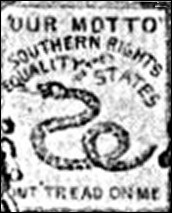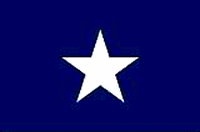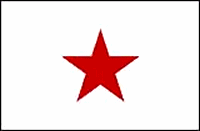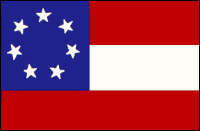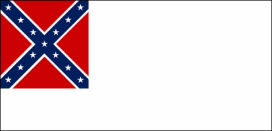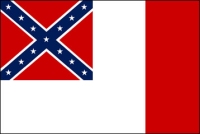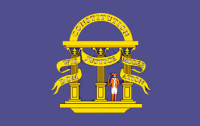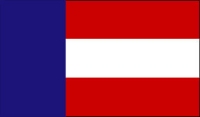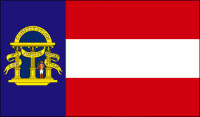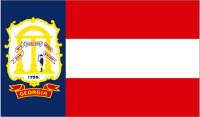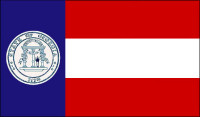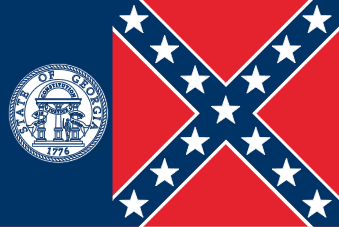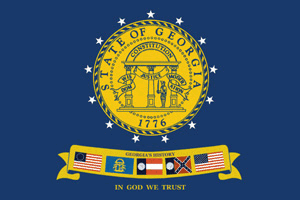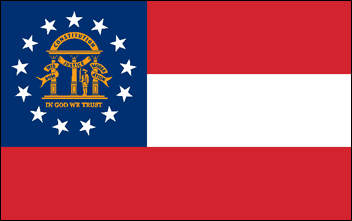The Georgia State Flag
The history of the flags that have flown over or were intended to fly over the State of Georgia is a long and twisted one with many unanswered questions. Many intended designs were never implemented. Many statutory designs were altered in practice either by design or misunderstanding.
Georgia was one of the thirteen original colonies, providing signatories to the Declaration of Independence and the 1787 United States Constitution. Georgia ratified the Constitution on January 2, 1788, becoming the third state to do so.
Until the Civil War, the flag of the United States of America flew over the State of Georgia.
Two days after the election of President Lincoln, on November 8, 1860, perhaps the first of the so-called "secession flags" was raised in Savannah, Georgia. The flag depicted a coiled snake on a white background and was inscripted "Our Motto, Southern Rights, Equality of the States, Don't Tread on Me." The graphic to the left depicts this banner. It is part of a lithograph captioned "The first Flag of Independence raised in the South, by the Citizens of Savannah, Ga. November 8th 1860". For more on this flag, including the full lithograph and an early banner expressing similar sentiments, visit the Carl Vinson Institute of Government at the University of Georgia.
As the sentiment of more and more Georgians embraced the idea of seceding from the Union, unofficial "secession flags" appeared all over the state, generally depicting a single star on a solid background. While each state was represented by one star on the Stars and Stripes, the single star on the secession flags indicated that the state had withdrawn from, or intended to withdraw from, the Union.
The most well known of the single-star flags is the "Bonnie Blue Flag" immortalized in song. This flag reportedly consisted of a single white star centered on a blue field. No hard evidence has come to light that the "Bonnie Blue Flag" was ever seen in Georgia, but a single-star flag with a red star on a white field was reported in use in Augusta and in Millidgeville in January, 1861. Millidgeville served as Georgia's capital from 1807 to 1868.
During the Civil War, Georgia flew the two national flags of the Confederate States of America (CSA).
The First National Flag (Stars and Bars) was used from 1861 to 1863. Concern over the similarity of the Confederate flag to the flag of the United States led to a change in design and the Second National Flag. Difficulty distinguishing the Stars and Bars from the Stars and Stripes from a distance, particularly in battle, was one reason given for the change.
The Second National Flag (Stainless Banner) was used beginning in 1863. As with the Stars and Bars, some saw shortcomings with the Stainless Banner. Though the official specification for the flag detailed in the Flag Act of 1863 described a flag whose length was twice as long as its width, the flag was often shortened to a more traditional dimension. Some have said this was to prevent the white flag for being mistaken for a flag of surrender.
In the late months of the Civil War, on March 4, 1865, CSA President Jefferson Davis signed a bill creating a third design for the Confederate National Flag, but it is not certain how many of these flags were made or if any were actually raised. This third flag's width was designated to be two thirds its length; a more traditional shape than the Stainless Banner. The field remained white but the outer half of the field consisted of a vertical red band.
The Civil War ended and Georgia was readmitted to the Union, but by 1879, the Georgia General Assembly had not passed any law to establish an official state flag. Various flags were seen across the state during the period after the Civil War. These were probably considered as banners of the various state militias rather than as political representations of the State of Georgia. However a flag bearing the Georgia Coat of Arms, probably originating from a military banner, is often considered as an unofficial flag of Georgia up until 1879 when an official version was described in law.
A first step was made toward an official state flag in an 1879 law regarding volunteer troops. A provision was included that "Every battalion of volunteers shall carry the flag of the State, when one is adopted by Act of the General Assembly, as its battalion colors."
The next day, State Senator Herman H. Perry introduced legislation that gave Georgia its first official state flag. A Confederate veteran, Colonel Perry's proposal was strongly influenced by the First National Flag of the Confederate States of America. His design took the Stars and Bars, removed the stars and extended the blue canton to the bottom of the flag. Governor Alfred H. Colquitt approved this flag on October 17, 1879.
In 1902, Georgia embarked on a major reorganization of its state militia laws. As part of this effort the Georgia General Assembly made a change to the flag design and stipulated that the State Coat of Arms be stamped on the plain blue field of the canton. Today, there is no evidence that this flag, specified by law, was ever made or put into use.
What do exist today are flags that are related to the official 1902 design specification but differing in one way or another.
In 1904, the flag in use is stamped with the coat of arms, including the state seal's adoption date (1799) on a gold-outlined white shield. A red ribbon with the name "GEORGIA" floats below the shield. This version of the flag appears to have been the generally accepted version from around 1902 to 1920. The white shield, state seal adoption date, and the ribbon with the state name were not part of the legal specification.
In 1914, the General Assembly changed the date on the Great Seal of the State of Georgia from 1799 (the year the seal was adopted) to 1776 (the year of independence). It is speculated that this change in date to the state seal may have led to the next "unofficial" flag standard.
Sometime during the 1920s the design of the flag in use changed again. But it was not due to legislative action or an attempt to align with the legal specification. In fact, the new change stepped a little further from the design specified by the 1902 law and stamped the Great Seal of the State of Georgia, rather than the coat of arms, on the blue canton. The ribbon bearing the state name was eliminated.
How and why these departures from the official design became standard is not really known.
In early 1955, an Atlanta attorney proposed a new flag design, one that would incorporate the Confederate Battle Flag. At the 1956 session of the General Assembly, State Senators Jefferson Lee Davis and Willis Harden introduced Senate Bill No. 98 to change the state flag design again. The 1956 flag design specified the same blue canton as defined in 1902, stamped with the Great Seal of the State of Georgia, similar to the flag that flew from some time in the 1920s. The Confederate Battle Flag was incorporated as the flag's field. House Bill No. 98 was signed into law by Governor Marvin Griffin on February 13, 1956, effective July 1, 1956.
For the first time in Georgia's history, the flag that flew over the capitol was as specified by law. Though minor differences did appear, this flag flew over the state of Georgia for 45 years until 2001.
By the late 1960s, some Georgia residents were expressing dismay with the 1956 design, calling the inclusion of the Confederate Battle Flag offensive and representative of a distasteful segment of Georgia history. For years the design of the flag was challenged. Numerous bills were introduced in the 1980s and the 1990s calling for a return to the pre-1956 design.
In 2000, Atlanta architect Cecil Alexander designed a new flag that was intended to recognize the Confederate Battle Flag's historical significance while minimizing its prominence as representative of the State of Georgia.
This flag depicted the Great Seal of Georgia, in "Dahlonega Gold" centered on a blue field. Thirteen stars circled the seal representing Georgia's role as one of the 13 original colonies of the United States. Under the seal and the stars, a banner titled GEORGIA'S HISTORY showed five of the flags that have flown over the state.
- The first flag was that of the United States, with its 13 stars, one for each of the colonies, circled on the blue canton.
- The next design was a pre-1879 design that featured the Coat of Arms from the 1799 seal. No one knows who was responsible for this design.
- The third flag was one that began to appear in the 1920s. This design was built upon the 1879 design of Colonel Herman H. Perry by adding the Great Seal of Georgia to the blue canton.
- The fourth flag flew over Georgia from 1956 to 2001.
- The final flag on the banner was the current flag of The United States.
House Bill No. 16 to adopt this flag was first read in the Georgia House on January 9, 2001. It was amended to include "IN GOD WE TRUST "beneath the ribbon of flags. As amended, House Bill No. 16 was adopted in the Georgia House on January 24, 2001 and rushed to the Georgia Senate where it passed on January 30, 2001.
Governor Roy Barnes signed the legislation on January 31, 2001 and on that same day, a new flag was quietly raised over the state capitol.
Perhaps destined for failure from the beginning, the new flag was consistently targeted for criticism. Over the next two years, controversy seemed to follow the Georgia flag wherever it went. While some Georgians were satisfied that the new flag offered a viable representation of the state, others criticized the flag's design. Some Georgians were quite vocal in their distaste for the new flag and called it an assault on their heritage. Others simply criticized the flag as "bad design." Arguments over the Georgia State Flag continued.
When Governor Sonny Perdue took office in 2003, he promised to end the controversy once and for all by offering a referendum on the flag to the people of Georgia. His intention was to put the question to "the people" of the state. He ran into a snag however. The Georgia Constitution states that the flag is to be determined by the "General Assembly" so a popular referendum was out of the question.
Compromises were made and House Bill No. 380, specifying a new flag design and a non-binding popular referendum on the new flag to be held in 2004, was read in the House for the first time on February 13, 2003.
House Bill No. 380 was passed by both houses of the Georgia General Assembly by May 5, 2003 and signed into law by Governor Sonny Perdue, three days later, on May 8, 2003. The law went into effect immediately.
The 2003 flag is reminiscent of the First National Flag of the Confederate States of America, the Stars and Bars. The flag consists of a square canton on three horizontal bars of equal width. The top and bottom bands are scarlet and the middle band is white. The bottom scarlet band extends the entire length of the flag. The top two bands extend from the canton to the end of the flag. Centered in the square blue canton is a gold representation of the Georgia coat of arms. Directly under the coat of arms are the words "IN GOD WE TRUST" in upper case letters. Thirteen white five-pointed stars circle the coat of arms and the wording symbolizing Georgia and the 12 other states that formed the United States of America.
The bill signed by Governor Perdue also called for a non-binding "advisory referendum" to determine whether the people of the state wished to keep the new, 2003 flag. The referendum, scheduled to be held on the date of the 2004 Presidential Primary, offered two choices to Georgians; keep the 2003 design as the Official Georgia State Flag or revert to the 2001 design.
On March 2, 2004, the people of Georgia voted 3-1 to keep the 2003 Perdue flag flying over Georgia.
Georgia Flag Law
The following information was excerpted from the Georgia Code, Title 1, Chapter 4.
TITLE 50. STATE GOVERNMENT.
CHAPTER 3. STATE FLAG, SEAL, AND OTHER SYMBOLS.
ARTICLE 1. STATE AND OTHER FLAGS.
§ 50-3-1. Description of state flag; militia to carry flag; defacing public monuments; obstruction of Stone Mountain .
(a) The flag of the State of Georgia shall consist of a square canton on a field of three horizontal bands of equal width. The top and bottom bands shall be scarlet and the center band white. The bottom band shall extend the entire length of the flag, while the center and top bands shall extend from the canton to the fly end of the flag. The canton of the flag shall consist of a square of blue the width of two of the bands, in the upper left of the hoist of the flag. In the center of the canton shall be placed a representation in gold of the coat of arms of Georgia as shown in the center of the obverse of the Great Seal of the State of Georgia adopted in 1799 and amended in 1914. Centered immediately beneath the coat of arms shall be the words "IN GOD WE TRUST" in capital letters. The coat of arms and wording "IN GOD WE TRUST" shall be encircled by 13 white five-pointed stars, representing Georgia and the 12 other original states that formed the United States of America. Official specifications of the flag, including color identification system, type sizes and fonts, and overall dimensions, shall be established by the Secretary of State, who pursuant to Code Section 50-3-4 serves as custodian of the state flag. Every force of the organized militia shall carry this flag while on parade or review.
(b)(1) It shall be unlawful for any person, firm, corporation, or other entity to mutilate, deface, defile, or abuse contemptuously any publicly owned monument, plaque, marker, or memorial which is dedicated to, honors, or recounts the military service of any past or present military personnel of this state, the United States of America or the several states thereof, or the Confederate States of America or the several states thereof, and no officer, body, or representative of state or local government or any department, agency, authority, or instrumentality thereof shall remove or conceal from display any such monument, plaque, marker, or memorial for the purpose of preventing the visible display of the same. A violation of this paragraph shall constitute a misdemeanor.
(2) No publicly owned monument or memorial erected, constructed, created, or maintained on the public property of this state or its agencies, departments, authorities, or instrumentalities in honor of the military service of any past or present military personnel of this state, the United States of America or the several states thereof, or the Confederate States of America or the several states thereof shall be relocated, removed, concealed, obscured, or altered in any fashion; provided, however, that appropriate measures for the preservation, protection, and interpretation of such monuments or memorials shall not be prohibited.
(3) Conduct prohibited by paragraphs (1) and (2) of this subsection shall be enjoined by the appropriate superior court upon proper application therefor.
(4) It shall be unlawful for any person, firm, corporation, or other entity acting without authority to mutilate, deface, defile, abuse contemptuously, relocate, remove, conceal, or obscure any privately owned monument, plaque, marker, or memorial which is dedicated to, honors, or recounts the military service of any past or present military personnel of this state, the United States of America or the several states thereof, or the Confederate States of America or the several states thereof. Any person or entity who suffers injury or damages as a result of a violation of this paragraph may bring an action individually or in a representative capacity against the person or persons committing such violations to seek injunctive relief and to recover general and exemplary damages sustained as a result of such person's or persons' unlawful actions.
(c) Any other provision of law notwithstanding, the memorial to the heroes of the Confederate States of America graven upon the face of Stone Mountain shall never be altered, removed, concealed, or obscured in any fashion and shall be preserved and protected for all time as a tribute to the bravery and heroism of the citizens of this state who suffered and died in their cause.
HISTORY: Ga. L. 1916, p. 158, § 3; Code 1933, § 86-1004; Ga. L. 1951, p. 311, § 43; Ga. L. 1955, p. 10, § 90; Ga. L. 1956, p. 38, § 1; Ga. L. 2001, p. 1, § 1; Ga. L. 2003, p. 26, § 1; Ga. L. 2004, p. 731, § 1.
§ 50-3-2. Pledge of allegiance to state flag
The following is adopted as the pledge of allegiance to the state flag: "I pledge allegiance to the Georgia flag and to the principles for which it stands: Wisdom, Justice, and Moderation."
HISTORY: Ga. L. 1951, p. 311, § 47; Ga. L. 1955, p. 10, § 94.
§ 50-3-3. Display of state flag
The state flag shall be displayed on appropriate occasions in the public and private schools of this state and in all patriotic meetings, and the citizens of the state are requested to take the pledge of allegiance set out in Code Section 50-3-2.
HISTORY: Ga. L. 1951, p. 311, § 48; Ga. L. 1955, p. 10, § 95.
§ 50-3-4. Designation of Secretary of State as custodian of state flag; procurement and furnishing of flags to schools
The Secretary of State is designated as the custodian of the state flag. From funds made available for such purpose, the Secretary of State shall procure suitable state flags; and he shall be authorized to furnish, without cost, to the various public schools of this state, to the superior and state courts, and to other departments and agencies of the state, counties, or municipal authorities, such flags for their use in displaying same. From such funds he is authorized also to procure such flags and facsimiles thereof as may cause the flag sufficiently and properly to be made known and displayed.
HISTORY: Ga. L. 1956, p. 38, § 2; Ga. L. 1970, p. 192, § 1; Ga. L. 1981, p. 986, § 1.
§ 50-3-5. Preservation of Confederate flags
The flags of the Georgia troops who served in the army of the Confederate States, and which have been returned to the state by the United States government, shall be preserved for all time in the capitol as priceless mementos of the cause they represented and of the heroism and patriotism of the men who bore them.
HISTORY: Ga. L. 1916, p. 158, § 3; Code 1933, § 86-1005; Ga. L. 1951, p. 311, § 44; Ga. L. 1955, p. 10, § 91.
§ 50-3-6. Display of Spanish-American War flags
The flags of the Georgia regiments which engaged in the Spanish-American War shall be displayed in the corridors of the capitol in a manner similar to those of the Confederate regiments.
HISTORY: Ga. L. 1916, p. 158, § 3; Code 1933, § 86-1006; Ga. L. 1951, p. 311, § 45; Ga. L. 1955, p. 10, § 92.
§ 50-3-7. Duty of Governor to accept flags
When any flag referred to in Code Section 50-3-5 or 50-3-6 is offered to the state, it shall be the duty of the Governor to accept it in behalf of the state and to make such provisions for its preservation as may be necessary to protect and preserve it from the ravages of time, dust, and moths.
HISTORY: Ga. L. 1916, p. 158, § 3; Code 1933, § 86-1007; Ga. L. 1951, p. 311, § 46; Ga. L. 1955, p. 10, § 93; Ga. L. 1982, p. 3, § 50.
§ 50-3-8. Use of national, state, or Confederate flag for advertising, selling, or promoting the sale of merchandise unlawful
(a) It shall be unlawful for any person, firm, or corporation to copy, print, publish, or otherwise use the flag of the United States, the flag, coat of arms, or state emblem of the State of Georgia, or the flag or emblem of the Confederate States of America, or any flag or emblem used by the Confederate States of America or the military or naval forces of the Confederate States of America at any time within the years 1860 to 1865, both inclusive, for the purpose of advertising, selling, or promoting the sale of any article of merchandise whatever within this state.
(b) Notwithstanding subsection (a) of this Code section, any person, firm, or corporation which contracts with the state to publish an official Code shall be authorized to use the state emblem on the cover of the publication. Utilization by the contracting person, firm, or corporation of the cover of the publication, with the state emblem thereon, for advertising purposes shall not constitute a violation of subsection (a) of this Code section.
HISTORY: Ga. L. 1960, p. 985, § 1; Ga. L. 1982, p. 3, § 50.
§ 50-3-9. Abuse of federal, state, or Confederate flag unlawful
It shall be unlawful for any person, firm, or corporation to mutilate, deface, defile, or abuse contemptuously the flag of the United States, the flag, coat of arms, or emblem of the State of Georgia, or the flag or emblem of the Confederate States of America by any act whatever.
HISTORY: Ga. L. 1960, p. 985, § 2.
§ 50-3-10. Use of flag for decorative or patriotic purposes
Nothing in this article shall be construed to prevent the use of the flag of the United States or any flag, standard, color, shield, ensign, or other insignia of the State of Georgia or of the Confederate States of America for decorative or patriotic purposes, either inside or outside of any residence, store, place of business, public building, or school buildi
HISTORY: Ga. L. 1960, p. 985, § 3.
§ 50-3-11. Penalty
Any person, firm, or corporation who violates any provision of Code Section 50-3-8 or 50-3-9 shall be guilty of a misdemeanor.
HISTORY: Ga. L. 1960, p. 985, § 4.
§ 50-3-12. State flags to honor service of deceased qualifying elected state officials
(a) The purpose of this Code section is to recognize and honor those men and women who have dedicated their lives to public service through the representation of the citizens of this state and, in devoted service thereto, safeguarded the health, safety, and welfare of the citizens of the State of Georgia. To carry out this purpose, the Secretary of State shall, from funds made available for such purpose, furnish, without cost, a state flag to honor the service of a deceased qualifying elected state official, which state flag may be displayed in the funeral service of the deceased elected state official and thereafter given to the elected state official's estate.
(b) For purposes of this Code section, a "qualifying elected state official" is an official elected to serve in a state position and shall include members of the Georgia General Assembly and any official elected by state-wide or local election to serve in a constitutionally created executive or judicial position or elected position on any constitutionally established board or commission. A person committing or convicted of a felony or crime of moral turpitude during or subsequent to holding office or who has been impeached or otherwise removed from public office shall not be considered a "qualifying elected state official."
(c) The Secretary of State is authorized to administer the recognition program set forth in this Code section and to provide rules and regulations and enter into contracts necessary for the administration of the provisions and the purposes set forth in the Code section.
HISTORY: Code 1981, § 50-3-12, enacted by Ga. L. 2006, p. 214, § 1/HB 1246.
§ 50-3-13. State flags to honor service of deceased qualifying public safety officers
(a) The purpose of this Code section is to recognize and honor those brave men and women who have dedicated their lives to the public safety of the citizens of this state and, in devoted service thereto, contributed to the safety, security, and individual freedom of the citizens of the State of Georgia. To carry out this purpose, the Secretary of State shall, if requested, from funds made available for such purpose, furnish, without cost, a state flag to honor the service of a deceased qualifying public safety officer, which state flag may be displayed in the funeral service of the deceased public safety officer and thereafter given to the officer's estate.
(b) For purposes of this Code section, a "qualifying public safety officer" is a peace officer, as defined in Code Section 35-8-2, sheriff, or firefighter, emergency medical technician, or emergency rescue specialist, as each is defined in Code Section 45-9-81, or member of the Georgia National Guard. In addition, "qualifying public safety officer" is an officer killed in the line of duty or an officer who has served as a qualifying public safety officer for a period of not less than five years. A person committing or convicted of a felony or crime of moral turpitude or whose certification or license to practice as a public safety officer is revoked or terminated shall not be considered a "qualifying public safety officer."
(c) It shall be the duty of any state or local agency with knowledge of the death of a qualifying public safety officer who is an employee of such agency or who retired from such agency to notify the Secretary of State's office for the purpose of providing a state flag to the deceased's estate. Any advocacy group representing the deceased or the deceased's department may also contact the Secretary of State on behalf of a deceased qualifying public safety officer.
(d) The Secretary of State is authorized to administer the recognition program set forth in this Code section and to provide rules and regulations and enter into contracts necessary for the administration of the provisions and the purposes set forth in the Code section.
HISTORY: Code 1981, § 50-3-13, enacted by Ga. L. 2006, p. 631, § 1/SB 381.
Source: Georgia General Assembly, Georgia Code, , July 7, 2007.
Source: University of Georgia:Carl Vinson Institute of Government, Flags That Have Flown Over Georgia, , July 7, 2007.
Source: Flags of the Fifty States and Their Incredible Histories: The Complete Guide to America's Most Powerful Symbols by Randy Howe. The Lyons Press; First edition edition (November 1, 2002).
Source: State Names, Seals, Flags and Symbols: A Historical Guide Third Edition, Revised and Expanded by Benjamin F. Shearer and Barbara S. Shearer. Greenwood Press; 3 Sub edition (October 30, 2001).
Source: State Names, Flags, Seals, Songs, Birds, Flowers, and Other Symbols by George Earlie Shankle. Reprint Services Corp; Revised edition (June 1971).
Additional Information
Flags That Have Flown Over Georgia:
History of the flags that have flown over Georgia from the Carl Vinson Institute of Government at the University of Georgia.
Georgia (U.S.):
FOTW "Flags of the World" Web Site.
State Flags:
Complete list of state flags with links to large pictures and images suitable for coloring.
Flag Terminology:
The parts of a flag and terms associated with its design.
Visit Our Flag Shop:
Purchase all kinds of flags and banners, lapel pins, 50 state flag sets, decals, patches, college banners at the Flag Shop.
Flags of the Fifty States and their Incredible Histories:
A complete guide to America's most powerful symbols by Randy Howe.
How Proudly They Wave: Flags of the Fifty States:
This book, by Rita D. Haban, is geared toward younger readers. |

